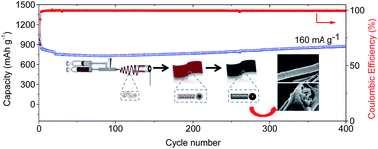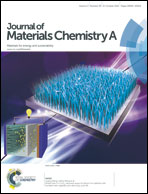Highly stable GeOx@C core–shell fibrous anodes for improved capacity in lithium-ion batteries†
Abstract
As a promising high capacity electrode material for lithium-ion batteries, germanium anodes are still to date restricted by the large volume change (>300%) during repeated cycling, which leads to a short cycle life and poor cycle stability in practical application. To overcome these challenges, herein a facile fabrication is reported to encapsulate GeOx nanoparticles into hollow carbon shells using co-axial electrospinning. This core–shell structure has shown remarkable improvements in alleviating the volume change of GeOx during cycling, minimizing the contact area between electrolyte and GeOx to form a stable solid electrolyte interface film, and providing enhanced electrical conductivity. In addition, Ge nanoparticles in the GeOx composite can promote the reversible capacity for the reversible utilization of Li2O. As a result, such a GeOx@C composite electrode exhibits excellent cycling ability with a reversible specific capacity of 875 mA h g−1 at 160 mA g−1 after 400 cycles, along with an improved rate capacity of 513 mA h g−1 at a high current density of 1600 mA g−1 upon 500 cycles.


 Please wait while we load your content...
Please wait while we load your content...